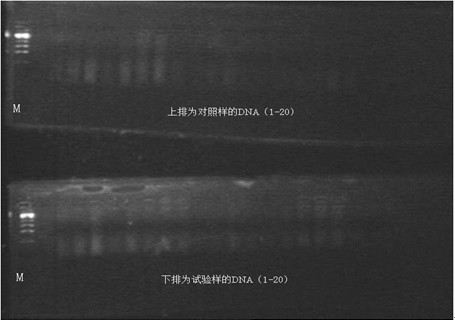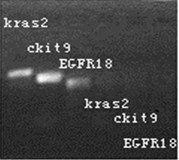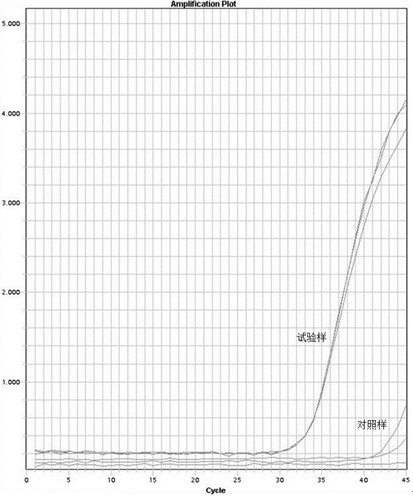Method for extracting residual nucleic acid from HE (haematoxylin eosin) dyeing piece
A technique for dyeing slides and nucleic acids, applied in the field of nucleic acid extraction, to achieve good practicality, reduce degradation, good economic benefits and social effects
- Summary
- Abstract
- Description
- Claims
- Application Information
AI Technical Summary
Problems solved by technology
Method used
Image
Examples
Embodiment 1
[0024] The decolouring method of embodiment 1 HE staining sheet
[0025] Immerse the HE-stained slide in xylene for 30 minutes, then gently slide off the cover glass. If the cover glass cannot slide off automatically, you can extend the time appropriately; take out the cover glass and continue soaking the HE-stained slide for 8-12 hours to fully remove the neutral gum; Soak in new xylene for 15 minutes; take out the cell sheet and soak in absolute ethanol for 10-20 minutes to fully remove xylene; replace with new absolute ethanol, soak for 15 minutes, then soak in 95% ethanol for 10 minutes; soak in 80% ethanol for 5 minutes ; Soak in 70% ethanol for 2 minutes; wash with tap water for 2 minutes; decolorize with 1% hydrochloric acid alcohol hematoxylin, and control it under the microscope until the cell sheet is almost colorless, which takes about 10 minutes. ; Soak the cell sheet in 2% oxalic acid aqueous solution for 3-5 minutes. If there is still color or the original sheet ...
Embodiment 2
[0028] Select 20 cases of HE-stained slides from 2008 to 2011 (gastroscopic specimens, provided by the Department of Pathology, Jiangsu Provincial Hospital of Traditional Chinese Medicine), one for each case, 20 test samples were decolorized by the decolorization process in Example 1, enriched to obtain target cells, and then used E.Z.N.A. from OMEGA bio-tekTM The Tissue DNA Kit kit was used to extract DNA from the enriched target cells, and the QIAGEN RNeasy? FFPE Kit kit was used to extract RNA from the enriched tumor tissue. The other 20 control samples were directly used without the decolorization step in Example 1. Corresponding extraction kit for DNA / RNA extraction, the results are as follows figure 1 As shown in Table 1, the DNA electrophoresis band extracted after decolorization is more complete than the DNA electrophoresis band extracted from tissue without decolorization. In the figure, the upper row is the DNA of the control sample (without decolorization step), The...
Embodiment 3
[0034] One piece of HE-stained slide after conventional processing of the puncture sample was used as the material (provided by the Pathology Department of Jiangsu Provincial Hospital of Traditional Chinese Medicine in 2009 for routine puncture pathological HE-stained slide) for decolorization, and the steps were as follows:
[0035] Immerse a puncture HE sample in xylene for 30 minutes, and gently slide off the cover glass; take out the cover glass, continue to soak the HE stained piece for 8~12 hours, and fully remove the neutral gum; replace it with new xylene, and soak for 15 minutes; Soak in water and ethanol for 10-20 minutes to fully remove xylene; replace with new anhydrous ethanol, soak for 15 minutes, then soak in 95% ethanol for 10 minutes; 80% ethanol for 5 minutes; 70% ethanol for 2 minutes; tap water for 2 minutes Decolorization with 1% hydrochloric acid alcohol hematoxylin takes about 10 minutes; soak in 2% oxalic acid aqueous solution for 20 minutes; wash with t...
PUM
 Login to View More
Login to View More Abstract
Description
Claims
Application Information
 Login to View More
Login to View More - R&D
- Intellectual Property
- Life Sciences
- Materials
- Tech Scout
- Unparalleled Data Quality
- Higher Quality Content
- 60% Fewer Hallucinations
Browse by: Latest US Patents, China's latest patents, Technical Efficacy Thesaurus, Application Domain, Technology Topic, Popular Technical Reports.
© 2025 PatSnap. All rights reserved.Legal|Privacy policy|Modern Slavery Act Transparency Statement|Sitemap|About US| Contact US: help@patsnap.com



